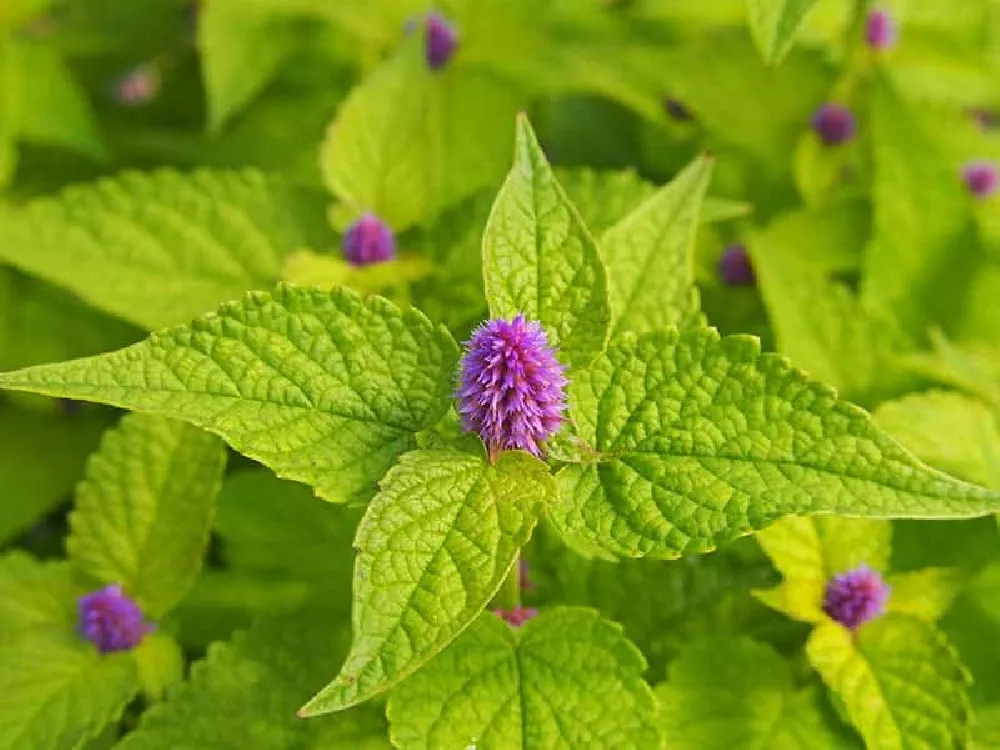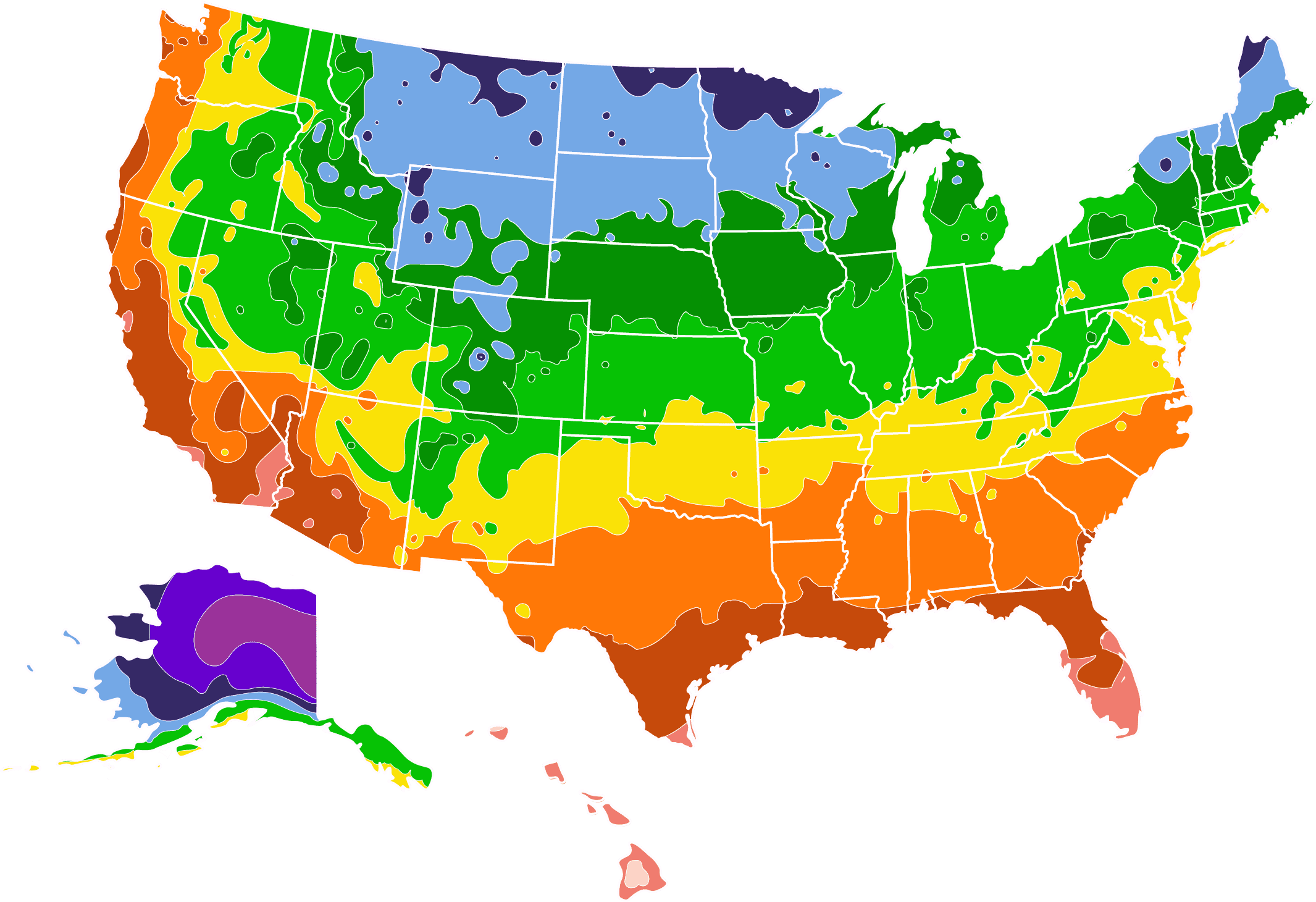- Home >
- Herb Plants >
- Anise Hyssop
Anise Hyssop for Sale - Buying & Growing Guide
Plant Care
Sunlight

Full sunlight is ideal for this plant, but it can tolerate occasional shade as well.
Watering
Consistent soil moisture makes for the best growth. Supply water when the first few inches of soil are dry.
Fertilizing

Fertilizer is generally not needed. Amending soil with organic matter is the best way to encourage growth.
Anise hyssop (Agastache foeniculum) is a member of the mint (Lamiaceae) family. With lavender-colored flowers and leaves that exhibit licorice-like flavors, this herbaceous plant is grown for both its beauty and its edibility. Growing to a height of around three feet, the bushy, upright plants will perform best when placed at the back of herb or pollinator gardens.
- Can be grown as a perennial in zones 4 to 8.
- Flower color will vary from whites to blues to purples.
- The plant’s flowers are attractive to bees, butterflies, and other pollinators.
Planting and Care
Planting instructions
Anise hyssop plants enjoy full sun, but they can also tolerate light shade if needed. If you wish to get a head start on the growing season, seeds can be started indoors about eight weeks before you want to plant them outside. Plant outside after any risk of frost has passed. The roots of the plant prefer well-drained, nutrient-rich soil with a slightly acidic pH. Anise hyssop can also be grown in containers for ornamental or culinary purposes.
Watering and nutrients
After planting your anise hyssop plants, thoroughly water them in. They prefer an evenly moist soil — when the top two inches of soil have become dry to the touch, the plants are ready for another watering. In the winter, your anise hyssop plants will likely go dormant. During this phase, you will not need to water them, as rainfall should provide more than enough moisture. Anise hyssop does not require heavy fertilization — mix in a small amount of compost or fertilizer when planting. Top-dress with compost each spring and avoid feeding during dormancy.
Pollination
Anise hyssop blooms from mid-summer to early fall. The flowers grow on a long spike that towers above the rest of the plant. Bees and butterflies, among other pollinators, are attracted to the plant’s display of flowers and will provide pollination for the herb. Anise hyssop participates in a mutualistic relationship with some of these pollinators. The nectar and pollen found in the flowers contain a chemical, methyl eugenol, that is known to provide nutrition and antibacterial properties for bees.
Pruning
Pruning is most beneficial to anise hyssop when performed in the early spring. Plants can be deadheaded through spring and early summer, removing dying flowers to promote the growth of new ones. Avoid pruning anise hyssop too late into the summer, as the new growth sites may not be able to survive the shock of cold weather. If using the herb in the kitchen, regular gathering of leaves is acceptable and should promote continued growth in the plant. Just make sure not to remove all of the leaves at once.
Pests and diseases
Fungal diseases can show up in anise hyssop plants for a variety of reasons. Improperly drained soil, lack of airflow, and over-watering allow fungi to proliferate and infect your plants. If you’re experiencing issues with mold and mildew, clear any debris around the plants and trim away any congested areas. Root rot is also known to occur when the soil is not properly drained. If a fungal disease has already set in, all-natural fungicides are available to remedy the situation.
Light
Anise hyssop thrives in both full sun and partial shade. It will grow well under the canopy of a taller tree that offers some shade or in open meadows where it experiences full sunlight all day long.
Although this plant loves the sun, it isn’t so keen on extreme heat, so if you do plant it in partial shade, try to position it so that it receives sun in the morning, and is shaded in the afternoon. This will offer the plant some relief from the sun during the hottest part of the day when the shade will grant some heat protection by lowering the temperature by a few degrees.
Anise hyssop can also be grown in a container, so you could experiment with different positions within your garden by moving the container around until you find a spot where the plant is at its happiest.
Temperature
This plant is hardy through USDA growing zones 4 to 8, but some varieties are appropriate for growing in zones 9 and 10.
The flowers of the plant appear in June, and if deadheaded will continue to bloom until the first frost in fall. Some varieties of the plant are frost tender and will die back during cold winters, but grow back from the roots the following spring. However, there are some types of anise hyssop, which can grow as annuals in cool climates, with the ability to survive in temperatures down to 10 ºF. Mulching the soil on top of the plants will go a long way to ensure their survival in low temperatures, as the mulch works to insulate the roots and protect them from freezing.
Propagation
Anise hyssop self-seeds easily, so if you refrain from deadheading some of your flowers once they are spent, you will likely find that you have a new patch of anise hyssops appearing the following spring from seeds that have dropped. If you prefer not to have spontaneous anise hyssop growing, make sure to remove all spent flowers from the plant in fall to prevent the seeds from settling in the ground.
To grow the plant from seed, you can start early by sowing the seeds indoors and transplanting them outside when they are seedlings, or you can plant seeds directly in the ground outside. Anise hyssops usually bloom in their first year, so the advantage of sowing the seeds early is that you will have flowers sooner than if they were sown outdoors.
To sow seeds, whether it be inside or outside, simply sprinkle the seeds on the soil and keep them moist. These seeds need light to germinate, so don’t cover them over with soil, and if sowing indoors, then make sure you place them in a well-lit environment.
When the seedlings are young, they will need plenty of water to develop, but once a strong root system has developed, you can cut back on the watering. Thin out seedlings to allow the strongest plants space to grow, and remove any weeds growing nearby as these can inhibit growth. Once mature, these plants can also be propagated by division (Royal Horticultural Society).
Anise Hyssop Varieties
The International Herb Association has named anise hyssop as the 2019 Herb of the Year (Penn State University Extension). However, when it comes to growing your own aromatic plant, there are many varieties to choose from, with different cultivars ranging in height, hardiness, and flower color. Some even feature unusual foliage to add further interest to their ornamental quality. These include the following.
Golden Jubilee
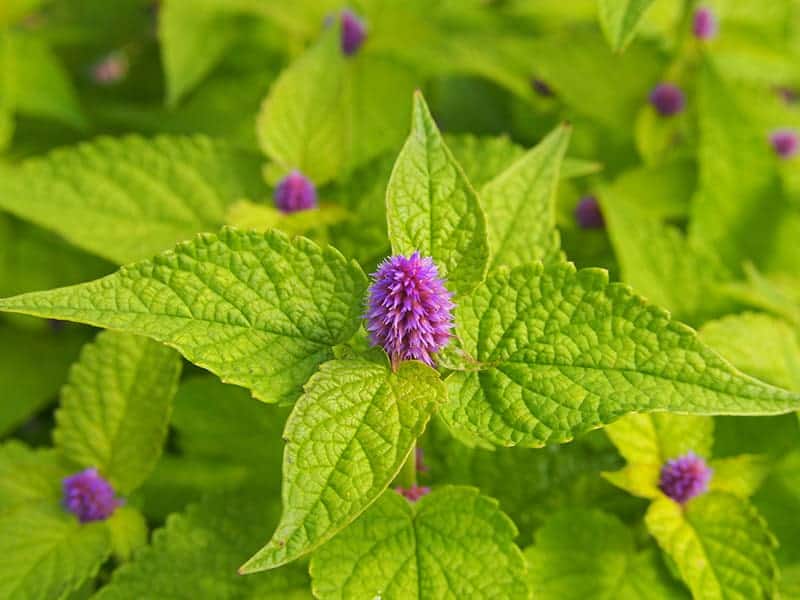
This is an award-winning plant with striking foliage in an almost neon shade of yellow lime, which is especially vibrant during spring. The flowers of this anise hyssop are purple, providing a perfect contrast against the background of the golden leaves.
Snow Spike
This variety of anise hyssop produces fresh white flowers and grows to a typical height of 3 feet.
Alabaster
Another white flowering variety, this herb produces a sparser plant than most anise hyssops, giving a less dense and bushy appearance.
Blue Fortune
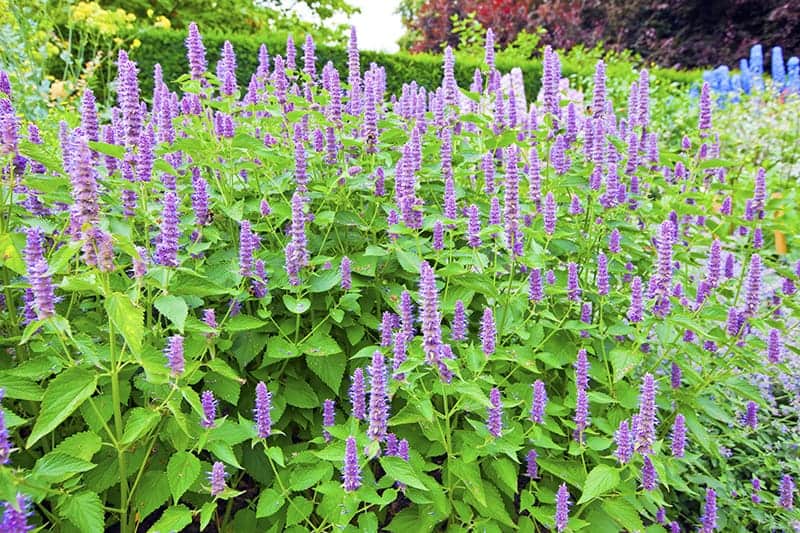
This variety is a hybrid between Agastache foeniculum and Agastache rugosa, created by a grower in the Netherlands. It grows to around 3 feet tall, producing large leaves and chunky spikes of baby blue blooms. The plant is sterile, meaning it cannot produce seeds. While this means that you won’t be able to grow more of the plant from its seeds, it does mean a longer blooming period is guaranteed. This is a popular variety that won the 2003 RHS Award of Garden Merit.
Red Fortune
This is another hybrid, producing pretty pink flowers. Though attractive as an ornamental, this variety is notedly less attractive to bees and butterflies than other types of anise hyssop.
Blue Boa
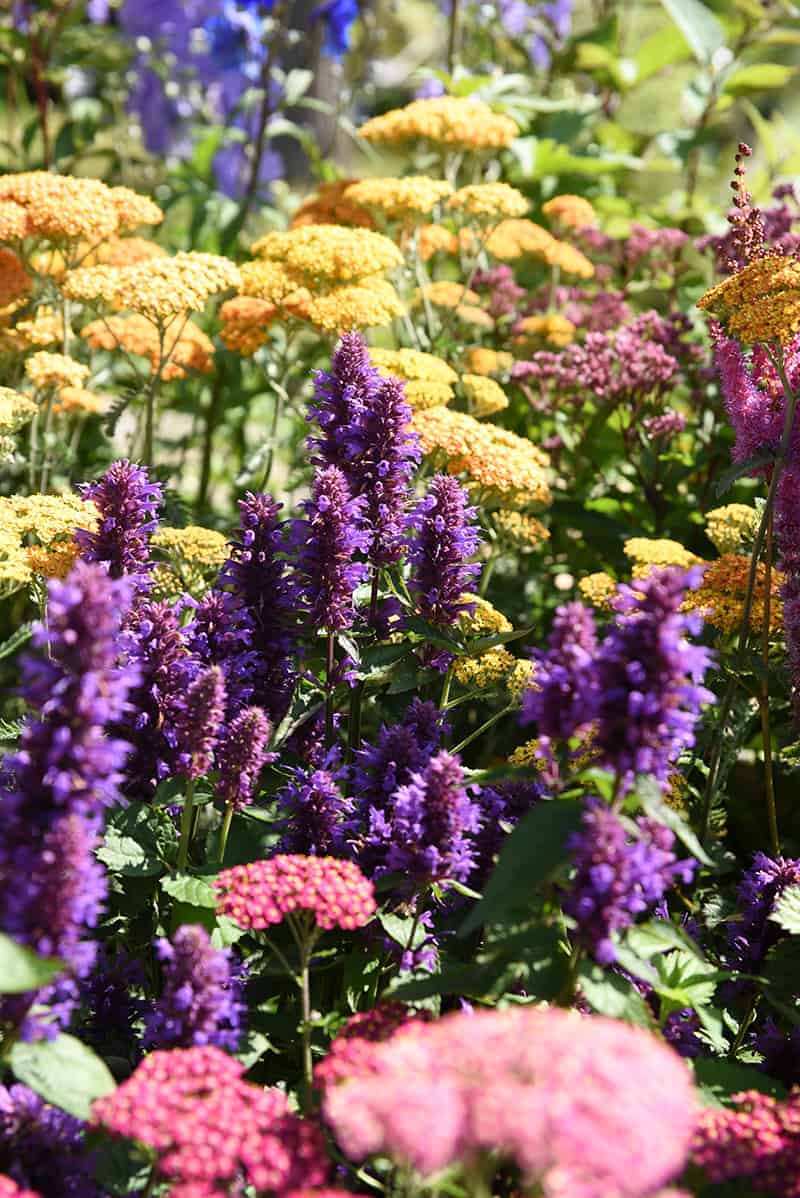
This award-winning variety closely resembles the lavender plant, with its deep purple flowers sitting in 5-inch clusters on top of tall spikes. It grows to between 2 and 3 feet in height and is suitable for growing in both borders or container gardens.
FAQs
Is anise hyssop edible?
How do you divide anise hyssop?
Anise hyssop can be propagated a few ways, the most popular of which is division. The plant develops underground rhizomes, which are stem-like structures that have the ability to produce new growth. These rhizome clumps can be dug up, divided, and re-planted to increase the number of anise hyssop plants in your garden. This process is best performed in the spring for optimal growth. Like most herbs, anise hyssop can also be propagated through cuttings.
What grows well with anise hyssop?
Anise hyssop makes an excellent addition to pollinator gardens. It attracts a wide variety of insects, increasing the ecological diversity in your garden. Lately, it has become a staple in herb gardens everywhere, growing well alongside basil, oregano, and other herbs. The plant is native to waterways, including rivers, streams, and lakes, a fact that causes their moisture needs to be greater than other plants. Anise hyssop will tolerate a variety of conditions, but you should avoid planting it with species that require dry soil.
Is anise hyssop annual or perennial?
Anise hyssop performs well as an annual or a perennial. In USDA Hardiness Zones 4 to 8, the plant will die back over the winter, emerging again in the spring with new growth. The plant will perform as an annual in cooler and warmer zones. When grown in your home or greenhouse, the plant will continually produce new foliage and can be kept alive for years. Anise hyssop's vigorous root system allows it to grow new copies of itself when the original iteration dies.
